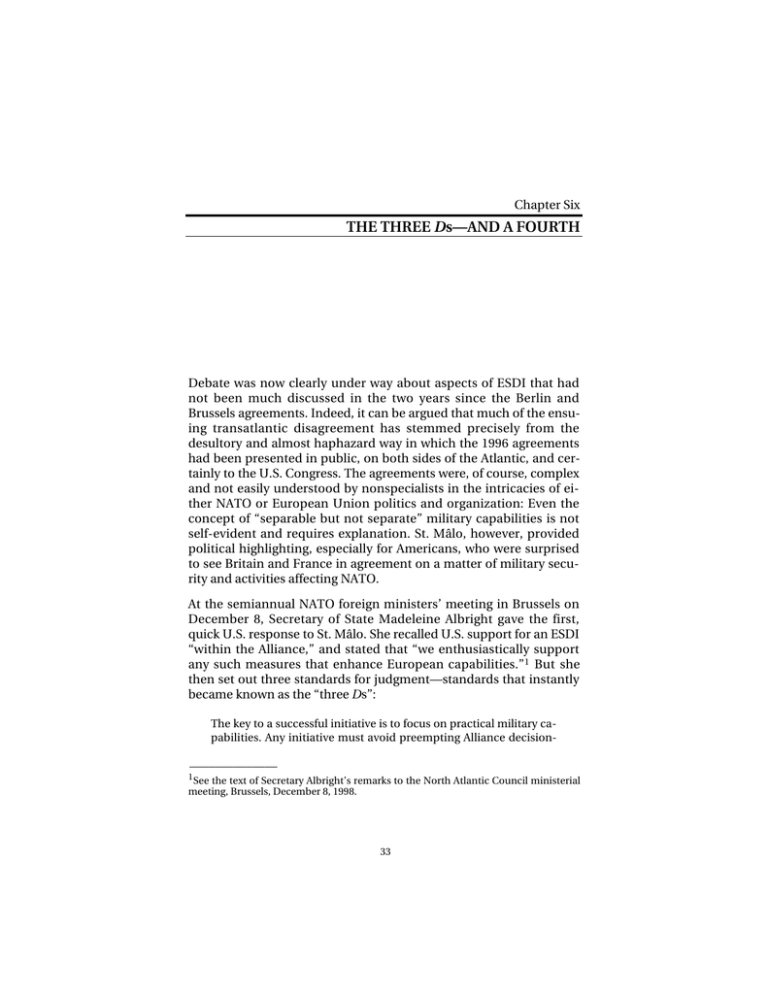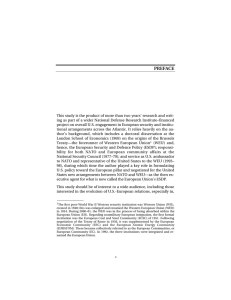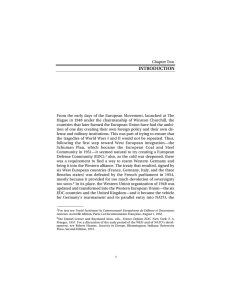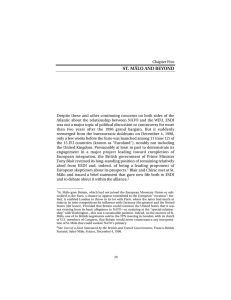D
advertisement

Chapter Six THE THREE Ds—AND A FOURTH Debate was now clearly under way about aspects of ESDI that had not been much discussed in the two years since the Berlin and Brussels agreements. Indeed, it can be argued that much of the ensuing transatlantic disagreement has stemmed precisely from the desultory and almost haphazard way in which the 1996 agreements had been presented in public, on both sides of the Atlantic, and certainly to the U.S. Congress. The agreements were, of course, complex and not easily understood by nonspecialists in the intricacies of either NATO or European Union politics and organization: Even the concept of “separable but not separate” military capabilities is not self-evident and requires explanation. St. Mâlo, however, provided political highlighting, especially for Americans, who were surprised to see Britain and France in agreement on a matter of military security and activities affecting NATO. At the semiannual NATO foreign ministers’ meeting in Brussels on December 8, Secretary of State Madeleine Albright gave the first, quick U.S. response to St. Mâlo. She recalled U.S. support for an ESDI “within the Alliance,” and stated that “we enthusiastically support any such measures that enhance European capabilities.”1 But she then set out three standards for judgment—standards that instantly became known as the “three Ds”: The key to a successful initiative is to focus on practical military capabilities. Any initiative must avoid preempting Alliance decision- ______________ 1 See the text of Secretary Albright’s remarks to the North Atlantic Council ministerial meeting, Brussels, December 8, 1998. 33 34 The European Security and Defense Policy making by de-linking ESDI from NATO, avoid duplicating existing efforts, and avoid discriminating against non-EU members [emphasis added].2 1. DE-LINKING The first “D”—de-linking—clearly related to the idea of “autonomous” European action introduced in the St. Mâlo declaration, along with the absence of the ritual words “separable but not separate” military capabilities. While not restated on this occasion, the U.S. position was clear: For the United States to agree to the release of NATO assets for WEU use—in major part U.S. assets—the essence of the carefully crafted Berlin-Brussels decisions had to be honored.3 On this point, the ambiguities of St. Mâlo, coupled with the sudden shift in the British position on ESDI, had led the United States to raise a warning flag.4 1+. DECOUPLING Behind U.S. concern about de-linking was also an unstated but longstanding concern within the alliance that, somehow, actions by either the United States or its European allies would lead the security of the two sides of the Atlantic to be decoupled. This concept, more ______________ 2 Ibid. 3 Indeed, Albright concluded that “We all agree that we need to finish ESDI based on the Berlin decisions by the April [1999] summit” [emphasis added] (ibid.). 4 The foreign ministers’ communiqué on this point was unexceptional, calling for completing the “work on implementing the Berlin and Brussels decisions related to ESDI” by the April 1999 Washington summit, and asking the North Atlantic Council in permanent session “to make recommendations on how best to further enhance the effectiveness of ESDI within the Alliance” (Ministerial Meeting of the North Atlantic Council, Final Communiqué, NATO Headquarters, Brussels, NATO Press Release M-NAC-2(98)140, December 8, 1998, paragraph 4. Later, the NATO defense ministers also passed over the issue lightly: The fundamental objectives of this [internal] adaptation [of the alliance] are to enhance the Alliance’s military effectiveness for the full range of its missions, to preserve the transatlantic link, and to develop the ESDI within the Alliance (Meeting of the North Atlantic Council in Defence Ministers’ Session, Final Communiqué, Brussels, NATO Press Release M-NAC-D2(98)152, December 17, 1998, paragraph 13). The Three Ds—and a Fourth 35 political than military and usually expressed in the negative (as the need to “avoid decoupling”) lay behind the fundamental security arrangements of the cold war and most of the efforts by the United States during that time to demonstrate that it would be prepared to initiate the use of nuclear weapons on the allies’ behalf in response to Soviet and Warsaw Pact conventional force aggression against Western Europe. The decoupling issue was also a central feature of allied debate over the Reagan administration’s proposal in the 1980s for a Strategic Defense Initiative—with many Europeans worrying that a shield to protect the United States, however imperfectly, against nuclear attack would connote a loss of American willingness to share the same risks as the allies. This time, however, the shoe was on the other foot: concern in the United States that the European allies taking part in ESDI could create circumstances in which they would see their security as somehow decoupled from the Atlantic framework. Given the relatively small size and limited range of actions that might be undertaken by any European ESDI force—at least as formally presented in the Petersberg Tasks—this risk should have appeared to be minimal. But as a political matter, it gained greater currency in Washington and, rightly or wrongly, has been a source of concern ever since. This is so despite the fact that U.S. speculation about the risks of decoupling posed by ESDI—including St. Mâlo and its aftermath—goes against two clearly positive aspects of ESDI, welcomed by the United States: (1) the Europeans would be doing more for defense and hence for intra-allied burden sharing (however limited);5 and (2) some European military capacity, not solely bound up in NATO, could actually reassure Europeans of their ability to take some actions in circumstances in which the United States chose not to become engaged. By this argument, ESDI should reinforce European confidence in U.S. commitments to European security and thus the political and military coupling of the two sides of the Atlantic. ______________ 5 The French defense minister has argued that the prime objective of the common European security and defence policy is to strengthen our military capabilities so that Europeans can make a greater contribution to the security of their continent, within the Alliance framework, or within the EU (Alain Richard, French Minister of Defense, Speech to the “Wehrkunde,” Munich, February 3, 2001, www.france.diplomatie.fr/ europe/politique/defense/richard030201.gb.html. 36 The European Security and Defense Policy 2. DISCRIMINATING Discrimination against non-EU members was more tangible but not central, at least then, to the underlying debate about NATO-WEU relations. At the time of St. Mâlo, five members of NATO—Canada, Iceland, Norway, Turkey, and the United States—were not EU members, and now, with the addition to NATO of the Czech Republic, Hungary, and Poland, there are eight. Furthermore, despite its eligibility, Denmark had chosen not to become a full member of WEU. Would any or all of these states be able to take part in WEU military operations? The issue was most pertinent in regard to Turkey, which was struggling to be accepted as a potential member of the European Union and was still, by the time of the St. Mâlo declaration, being kept firmly outside the gate. At the Helsinki EU summit a year later, it was finally put on the list of countries that would be “destined to join the Union”—although, of course, “on the basis of the same criteria as applied to the other candidate States.”6 At one level, this issue of participation by NATO non-WEU members should not have emerged: After all, as a necessary condition of releasing any NATO assets for use by WEU, the North Atlantic Council would first have to approve it, by consensus, and Turkey has a veto. Further, lest Turkey be put under intense pressure by the Europeans in the council, the United States had promised to stand with it on this matter. In addition, NATO’s Berlin-Brussels agreements specifically provided for “the development, with the participation of all European Allies, of the ESDI within the Alliance;”7 and it had already been agreed that the non-EU members of NATO could take part in various aspects of WEU activities, including planning, by being “able ______________ 6 See Helsinki European Council, Presidency Conclusions, December 10–11, 1999, paragraph 12: The European Council welcomes recent positive developments in Turkey as noted in the Commission’s progress report, as well as its intention to continue its reforms towards complying with the Copenhagen criteria. Turkey is a candidate State destined to join the Union on the basis of the same criteria as applied to the other candidate States. Building on the existing European strategy, Turkey, like other candidate States, will benefit from a preaccession strategy to stimulate and support its reforms. 7 Meeting of the North Atlantic Council in Defence Ministers’ Session, June 13, 1996, op. cit., paragraph 8. The Three Ds—and a Fourth 37 to be associated to the [WEU] Planning Cell [set up by the Petersberg Declaration of June 1992] through a permanent liaison arrangement.” Also, “they will take part on the same basis as full members in WEU military operations to which they commit forces.”8 Thus the U.S. introduction of this “D” after St. Mâlo was designed to underscore a substantive point, especially in view of one underlying idea of ESDI: It is about increasing the storehouse of European security, writ large, by creating a capacity for EU states to have a Common Foreign and Security Policy and a defense component able to respond to CFSP decisions, at least regarding Petersberg Tasks. At another level, however, there has developed more serious concern regarding circumstances in which military actions would be taken within the ESDI framework but without calling upon NATO assets— as, obviously, would be the right of the WEU/EU, without let or hindrance from NATO or any of the allied states. This matter was certainly brought into play by the introduction, at St. Mâlo and afterward, of the idea that the new European construction should have the capacity to take autonomous action. But would non-EU NATO members be able to take part in WEU operations under these conditions? In theory, that point had already been settled in the Maastricht Treaty: ______________ 8 WEU Council of Ministers, June 19, 1992, op. cit., paragraph III.B. The planning ar- rangement (precisely for Iceland, Norway, and Turkey) was later expanded, so they may nominate officers to the Planning Cell in order to increase WEU’s planning capabilities and to enable WEU to draw more easily on the Associate Members’ expertise and resources for the tasks identified in the Petersberg Declaration” (WEU Council of Ministers, Kirchberg Declaration, “III. Declaration Following on from the ‘Document on Associate Membership’ of 20 November 1992,” Luxembourg, May 9, 1994). See also Document on Associate Members of WEU of the Republic of Iceland, the Kingdom of Norway and the Republic of Turkey, November 20, 1992: [The associate members] will be able to participate in their implementation [i.e., decisions made by member states] unless a majority of the member States, or half of the member States including the Presidency, decide otherwise. 38 The European Security and Defense Policy [Non-EU] European Member States of NATO are invited to become associate members of WEU in a way which will give them the possibility to participate fully in the activities of WEU [emphasis added].9 The issue has since been reopened, especially because ESDP has seemed to become more of a reality. In one form or another, virtually all of the NATO states that do not belong to the EU have made clear their concerns about being sidelined in the event of a military action within the framework of ESDP. And because it is not yet clear to what extent the EU—e.g., through the projected Headline Goal Task Force—will in fact want to draw upon NATO assets, even while the Europeans express a desire to be capable of autonomous action, discrimination against non-EU members is still a salient matter within NATO and in its relations with the EU. Nor is this just about the interests of the affected non-EU NATO countries (plus Denmark): It also relates to the abiding sense within NATO of shared experience, shared risks, and a shared political-strategic perspective. It is important to dwell a bit further on the case of Turkey. For most of the non-EU members of NATO, participation in ESDP has seemed a second-order matter, especially since they have not had major expectations for it, at least in the short to medium term, except in regard to the process of developing European integration. 10 Turkey’s problem has a more important character. As ESDI-ESDP has developed beyond the necessary reliance on NATO assets and Turkey’s potential veto, the issue by 2000 became whether Turkey would be able to take part in the full range of discussions and decisions within EU institutions, leading from the onset of a crisis to the actual use of ______________ 9 See Maastricht Declarations, December 10, 1991. Note that Canada is not covered by this phrase: A point that would later acquire significance for Ottawa. 10 To be sure, there was some effort by EU members to take advantage of the anomalous situation of differential memberships. Thus, Norway has at times been put under considerable pressure by some of the Europeans to “buy EU” in terms of defense goods—including high-performance aircraft. The argument made is that, because of its rejection of EU membership by referenda (1972 and 1994), Norway would lack access to Brussels institutions for purposes of influencing decisions by which, because of its membership in the European Economic Area, Norway would be bound even though it had no role in shaping these decisions. Showing favoritism to European arms suppliers has been represented as a way for Norway to be accorded some influence via the route of ESDP. “All is fair” in the arms trade as in other aspects of international life! Comments made to the author by various Norwegian government representatives, January 2000. The Three Ds—and a Fourth 39 force to achieve one Petersberg Task or another. The topic arose as late as the Washington summit of April 1999, even though the alliance’s new Strategic Concept was quite clear: [The allies were prepared to] make [NATO’s] assets and capabilities available for operations in which the Alliance is not engaged militarily under the political control and strategic direction either of the WEU or as otherwise agreed, taking into account the full participation of all European Allies if they were so to choose [emphasis added].11 Furthermore, the June 1999 European Council summit at Cologne set the goal of developing an effective EU-led crisis management in which NATO members, as well as neutral and non-allied members of the EU, can participate fully and on an equal footing in the EU operations [emphasis added]; . . . [and arrangements made would] allow non-EU European allies and partners to take part to the fullest possible extent in this endeavour.12 However, an element of ambiguity (or at least confusion) was also introduced, from the point of view of Turkey and similarly situated non-EU NATO members, when the EU endorsed a report that made clear that The Council of the European Union would . . . be able to take decisions on the whole range of political, economic, and military in- ______________ 11 See NATO, The Alliance’s Strategic Concept, Approved by the Heads of State and Government Participating in the Meeting of the North Atlantic Council in Washington, D.C., on 23rd and 24th April 1999, Release NAC-S(99)65, April 24, 1999, paragraph 30. Furthermore the document states that, regarding the EU’s “efforts to strengthen its security and defence dimension, . . . all European Allies should be involved in it, building on arrangements developed by NATO and the WEU” (ibid., paragraph 17). 12 Cologne European Council, Presidency Conclusions, June 3–4, 1999, “Annex III, European Council Declaration on Strengthening the Common European Policy on Security and Defence,” paragraph 3. It can be noted that these formulations did not use the designators “the” or “all” to modify “NATO members,” and “non-EU European allies.” But to isolate Turkey on that basis would be a lawyer’s quibble. 40 The European Security and Defense Policy struments at its disposal when responding to crisis situations [emphasis added].13 Thus, the Cologne summit text contained a critical distinction: [While ensuring] that all participants in an EU-led operation will have equal rights in respect to the conduct of that operation, . . . [this would be] without prejudice to the principle of the EU’s decisionmaking autonomy, notably the right of the Council to discuss and decide matters of principle and policy.14 When it became clear that Turkey would not have full access to this process, in December 2000 it placed a hold on further work between NATO and the EU on defining security relations between the two institutions. The EU could argue that it was not being ambiguous, but merely hair-splitting: “Participants in an EU-led operation” might have equal rights; but they would not become “participants” until relevant decisions had already been made by the European Council. This has proved to be the nub of the problem. For the United States, this matter regarding Turkey might be seen as a problem only in two respects: its relationship with Turkey (and aspirations to see it play a full role in Western security institutions and eventually become a member of the EU); and the U.S. desire to see NATO gain as much as possible from the EU in terms of arrangements that would keep ESDP from eroding NATO prerogatives. However, as the Turkish hold on formal agreements continued, a further and more important U.S. concern developed: The EU might forge ahead with its own developments, potentially widening the political and psychological gap with NATO, perhaps more by inadvertence than by design. 3. DUPLICATING At least at the time of St. Mâlo (December 1998), the most important and most tangible of the three (or four) U.S. “Ds” was duplication. On the face of it, Secretary Albright’s injunction “to avoid duplicating ______________ 13Ibid., paragraph 2. 14Ibid., paragraph 5. The Three Ds—and a Fourth 41 existing efforts” was simply a U.S. plea for the Europeans, in crafting ESDI, not to spend scarce resources on trying to create a second set of capabilities that they could just as easily obtain from NATO, on the basis of the 1996 grand bargain. Given that the military budgets of most European states were in fact decreasing (see Table 1), this was not an idle matter: Indeed, trying to avoid unnecessary duplication (beyond, say, the WEU’s having the machinery needed to provide it with the capacity to make decisions, to incorporate basic strategic planning, 15 and to exercise essential command and control) had been a major reason for creating ESDI within NATO, using NATO assets, rather than outside it: the principle of “separable but not separate” military capabilities. It seemed to the United States—and also to most military and budgetary experts—to make little sense to try creating a second set of military goods (especially expensive hardware) simply to be able to designate one set as “NATO” and the other as “WEU.” This was especially true since, as noted earlier, neither NATO nor the WEU (and its EU successor, the Headline Goal Task Force) in effect “owns” very much of this hardware, but rather calls upon national contributions when deciding to undertake a military operation.16 Of course, most U.S. analysts also judged that the WEU was not in fact very likely, by itself, to take any military action of any major size: They presumed that any substantial military challenge would also engage the United States, and thus, under the implicit concept of ______________ 15The WEU has long had its own planning cell. Following the Berlin-Brussels deci- sions, however, NATO has undertaken major responsibility for WEU planning, including the creation of a joint planning staff for CJTF headquarters. See Ministerial Meeting of the North Atlantic Council, June 13, 1996, op. cit., paragraph 6: We have also instructed the NATO Military Authorities to develop the terms of reference of the Combined Joint Planning Staff which would perform centralized CJTF headquarters planning functions and co-ordination with all relevant headquarters, as well as with forces that might serve under a CJTF headquarters, and as appropriate with the WEU Planning Cell. As discussed below, just where ESDP operational planning will take place has been a major issue in its relations with NATO. 16Even the EU’s project Headline Goal Task Force would consist largely of forces that could as easily find themselves employed in NATO-run military actions as EU-run actions. Koruny Kroner Francs DMs Drachma Forint 1000 Lire Francs Guilders Kroner Zlotys Escudos Peseta 1000 Liras Pounds Czech Rep. Denmark France Germany Greece Hungary Italy Luxembourg Netherlands Norway Poland Portugal Spain Turkey UK Utopia Currency Francs Country Belgium 28008 273695 1201473 393237 — 23842 15158 3734 35783 — 1177417 80901 257575 18453 — 1990 175534 21439 302864 1078751 403478 — 22224 12864 4194 31561 — 1171377 58986 238432 17468 — 1995 131156 21537 323744 20242 340749 1062949 399040 — 22117 12967 4650 31458 — 1318338 56573 234643 17611 — 1997 127803 R 1055100 390055 — 22454 13068 4341 31790 — 1250955 58076 233988 17426 — 1996 129190 20510 353579 1040030 381430 — 23578 12817 4985 32206 — 1435153 56699 227824 17647 — 1998 127260 Allied Defense Spending, 1990–2000 (1995 prices and exchange rates ) Table 1 20123 370788 1047385 403191 7770 23393 13424 5083 32902 106469 1495834 57618 230108 17498 31339 1999 128577 19910 419222 1109069 403191 7949 22890 12759 5117 32305 115143 1562216 57033 232613 16952 32682 2000a 129266 –23.5 10.7 –10.2 2.6 — –90.7 –15.1 12.3 –11.8 — –0.5 –27.1 –7.4 –5.3 — %-1 –25.3 Zapf –1.1 13.1 5.9 2.5 2.3 –2.2 –5.0 0.7 –1.8 8.1 4.4 –1.0 1.1 –3.1 4.3 %-2 0.5 42 The European Security and Defense Policy US $ Dollars Dollars US $ Europe Canada U.S. North Am. 365673 354956 14708 220294 1990 287933 278856 12457 184352 1995 273854 265599 11330 183737 1996 275510 263805 10574 181236 1997 265051 256667 11507 181479 1998 267042 258348 11932 188818 1999 274931 266762 11211 189741 2000a –21.3 –21.4 –15.3 –16.3 %-1 3.3 –6.0 — %-2 Utopia R Zapf Total US $ 585767 472284 457591 452746 446530 455861 464672 –19.4 NOTES: “%-1” is the percentage change from 1990 to 1995 spending. “%-2” is the percentage change from 1999 to 2000 spending. a 2000 figures are estimates. SOURCE: NATO, Tables on Total Defence Expenditures and Defence Expenditure Annual Volume Change, Press Release M-DPC-2 (2000) 107, December 5, 2000. Currency Country Table 1—continued The Three Ds--and a Fourth 43 44 The European Security and Defense Policy “NATO first”—at least as understood by the United States—the locus for decision and action would naturally shift to the alliance. As a result, any significant duplication of effort, with serious resource implications, would not contribute much in practice to meeting European security goals—which, by this logic, would almost always be shared by the United States. Nevertheless, the issue of “unnecessary duplication” has continued to be at the center of transatlantic debate about the future of ESDI-ESDP and its relationship to NATO.









